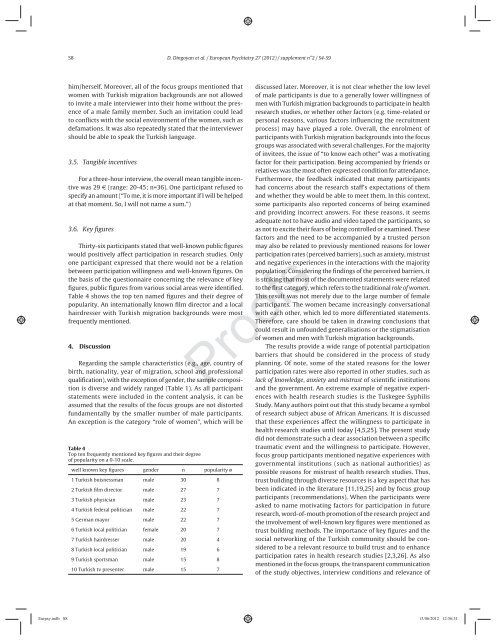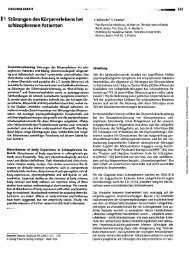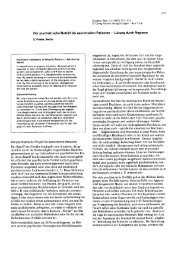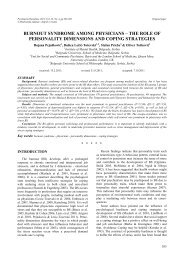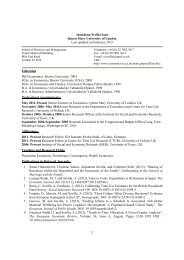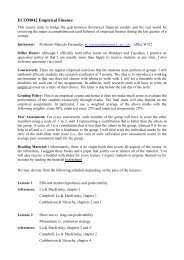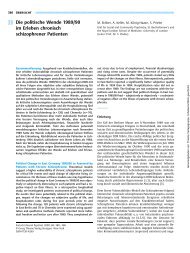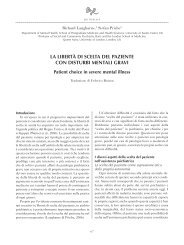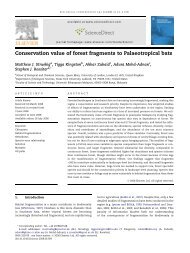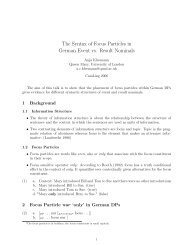Proofs - Personal Webspace for QMUL - Queen Mary, University of ...
Proofs - Personal Webspace for QMUL - Queen Mary, University of ...
Proofs - Personal Webspace for QMUL - Queen Mary, University of ...
Create successful ePaper yourself
Turn your PDF publications into a flip-book with our unique Google optimized e-Paper software.
S8 D. Dingoyan et al. / European Psychiatry 27 (2012) / supplement n°2 / S4-S9<br />
him/herself. Moreover, all <strong>of</strong> the focus groups mentioned that<br />
women with Turkish migration backgrounds are not allowed<br />
to invite a male interviewer into their home without the presence<br />
<strong>of</strong> a male family member. Such an invitation could lead<br />
to confl icts with the social environment <strong>of</strong> the women, such as<br />
defamations. It was also repeatedly stated that the interviewer<br />
should be able to speak the Turkish language.<br />
3.5. Tangible incentives<br />
For a three- hour interview, the overall mean tangible incentive<br />
was 29 € (range: 20- 45; n=36). One participant refused to<br />
specify an amount (“To me, it is more important if I will be helped<br />
at that moment. So, I will not name a sum.”)<br />
3.6. Key fi gures<br />
Thirty- six participants stated that well- known public fi gures<br />
would positively affect participation in research studies. Only<br />
one participant expressed that there would not be a relation<br />
between participation willingness and well- known fi gures. On<br />
the basis <strong>of</strong> the questionnaire concerning the relevance <strong>of</strong> key<br />
fi gures, public fi gures from various social areas were identifi ed.<br />
Table 4 shows the top ten named fi gures and their degree <strong>of</strong><br />
popularity. An internationally known fi lm director and a local<br />
hairdresser with Turkish migration backgrounds were most<br />
frequently mentioned.<br />
4. Discussion<br />
Regarding the sample characteristics (e.g., age, country <strong>of</strong><br />
birth, nationality, year <strong>of</strong> migration, school and pr<strong>of</strong>essional<br />
qualifi cation), with the exception <strong>of</strong> gender, the sample composition<br />
is diverse and widely ranged (Table 1). As all participant<br />
statements were included in the content analysis, it can be<br />
assumed that the results <strong>of</strong> the focus groups are not distorted<br />
fundamentally by the smaller number <strong>of</strong> male participants.<br />
An exception is the category “role <strong>of</strong> women”, which will be<br />
Table 4<br />
Top ten frequently mentioned key fi gures and their degree<br />
<strong>of</strong> popularity on a 0- 10 scale.<br />
well known key fi gures gender n popularity ø<br />
1 Turkish buisnessman male 30 8<br />
2 Turkish fi lm director male 27 7<br />
3 Turkish physician male 23 7<br />
4 Turkish federal politician male 22 7<br />
5 German mayor male 22 7<br />
6 Turkish local politician female 20 7<br />
7 Turkish hairdresser male 20 4<br />
8 Turkish local politician male 19 6<br />
9 Turkish sportsman male 15 8<br />
10 Turkish tv presenter male 15 7<br />
discussed later. Moreover, it is not clear whether the low level<br />
<strong>of</strong> male participants is due to a generally lower willingness <strong>of</strong><br />
men with Turkish migration backgrounds to participate in health<br />
research studies, or whether other factors (e.g. time- related or<br />
personal reasons, various factors infl uencing the recruitment<br />
process) may have played a role. Overall, the enrolment <strong>of</strong><br />
participants with Turkish migration backgrounds into the focus<br />
groups was associated with several challenges. For the majority<br />
<strong>of</strong> invitees, the issue <strong>of</strong> “to know each other” was a motivating<br />
factor <strong>for</strong> their participation. Being accompanied by friends or<br />
relatives was the most <strong>of</strong>ten expressed condition <strong>for</strong> attendance.<br />
Furthermore, the feedback indicated that many participants<br />
had concerns about the research staff’s expectations <strong>of</strong> them<br />
and whether they would be able to meet them. In this context,<br />
some participants also reported concerns <strong>of</strong> being examined<br />
and providing incorrect answers. For these reasons, it seems<br />
adequate not to have audio and video taped the participants, so<br />
as not to excite their fears <strong>of</strong> being controlled or examined. These<br />
factors and the need to be accompanied by a trusted person<br />
may also be related to previously mentioned reasons <strong>for</strong> lower<br />
participation rates (perceived barriers), such as anxiety, mistrust<br />
and negative experiences in the interactions with the majority<br />
population. Considering the fi ndings <strong>of</strong> the perceived barriers, it<br />
is striking that most <strong>of</strong> the documented statements were related<br />
to the fi rst category, which refers to the traditional role <strong>of</strong> women.<br />
This result was not merely due to the large number <strong>of</strong> female<br />
participants. The women became increasingly conversational<br />
with each other, which led to more differentiated statements.<br />
There<strong>for</strong>e, care should be taken in drawing conclusions that<br />
could result in unfounded generalisations or the stigmatisation<br />
<strong>of</strong> women and men with Turkish migration backgrounds.<br />
The results provide a wide range <strong>of</strong> potential participation<br />
barriers that should be considered in the process <strong>of</strong> study<br />
planning. Of note, some <strong>of</strong> the stated reasons <strong>for</strong> the lower<br />
participation rates were also reported in other studies, such as<br />
lack <strong>of</strong> knowledge, anxiety and mistrust <strong>of</strong> scientifi c institutions<br />
and the government. An extreme example <strong>of</strong> negative experiences<br />
with health research studies is the Tuskegee Syphilis<br />
Study. Many authors point out that this study became a symbol<br />
<strong>of</strong> research subject abuse <strong>of</strong> African Americans. It is discussed<br />
that these experiences affect the willingness to participate in<br />
health research studies until today [4,5,25]. The present study<br />
did not demonstrate such a clear association between a specifi c<br />
traumatic event and the willingness to participate. However,<br />
focus group participants mentioned negative experiences with<br />
governmental institutions (such as national authorities) as<br />
possible reasons <strong>for</strong> mistrust <strong>of</strong> health research studies. Thus,<br />
trust building through diverse resources is a key aspect that has<br />
been indicated in the literature [11,19,25] and by focus group<br />
participants (recommendations). When the participants were<br />
asked to name motivating factors <strong>for</strong> participation in future<br />
research, word- <strong>of</strong>- mouth promotion <strong>of</strong> the research project and<br />
the involvement <strong>of</strong> well- known key fi gures were mentioned as<br />
trust building methods. The importance <strong>of</strong> key fi gures and the<br />
social networking <strong>of</strong> the Turkish community should be considered<br />
to be a relevant resource to build trust and to enhance<br />
participation rates in health research studies [2,3,26]. As also<br />
mentioned in the focus groups, the transparent communication<br />
<strong>of</strong> the study objectives, interview conditions and relevance <strong>of</strong><br />
<strong>Pro<strong>of</strong>s</strong>


